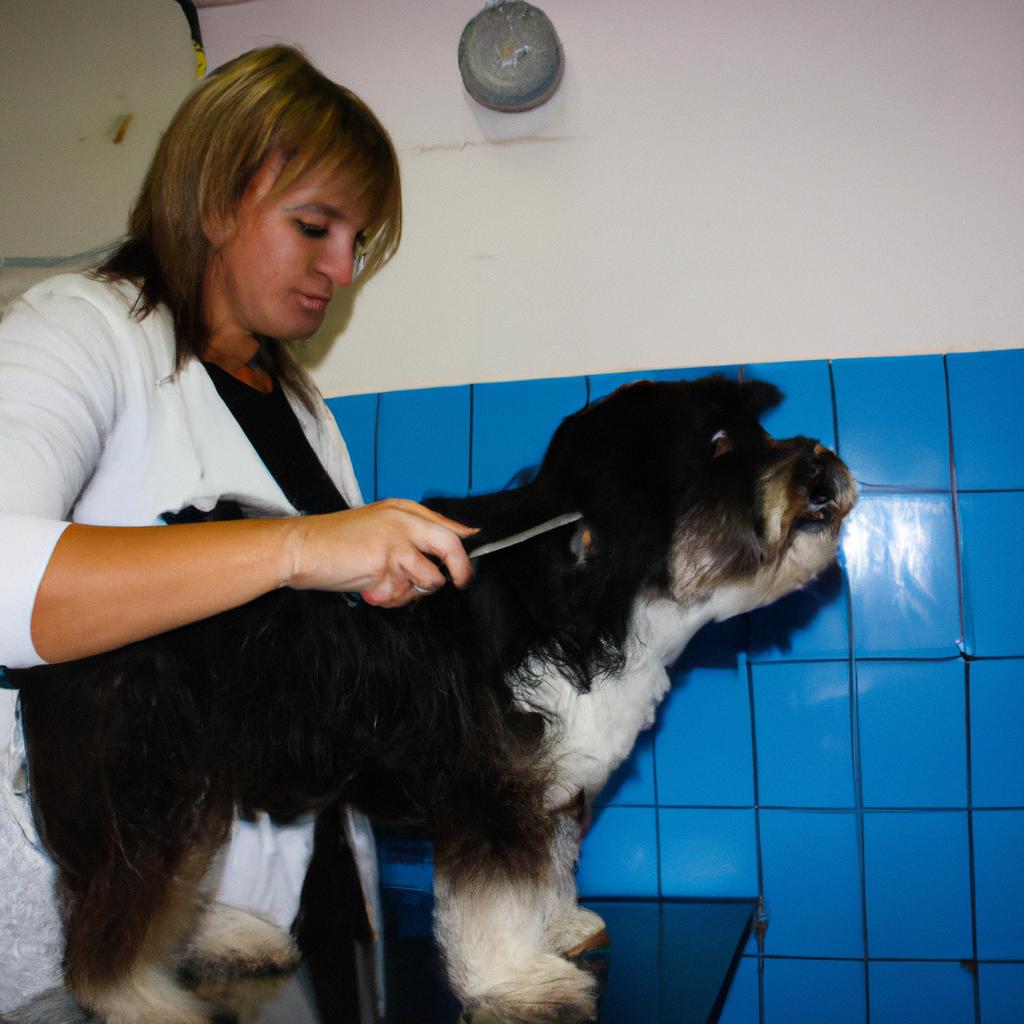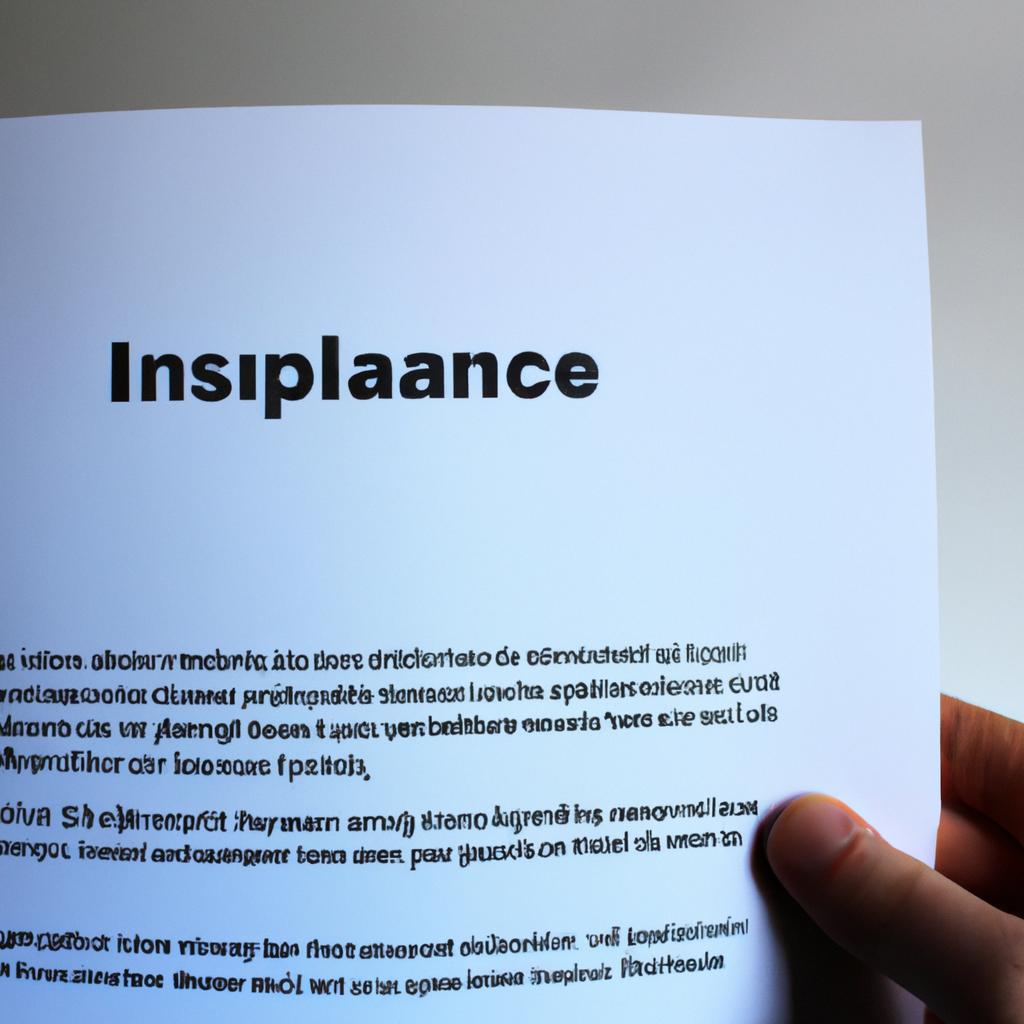Tax Deductions: Pet Grooming Expenses at Dog Grooming Salon in Pet Finance

In today’s society, pets have become an integral part of many households, providing companionship and joy to their owners. However, owning a pet comes with its fair share of responsibilities, including the grooming needs that ensure their health and well-being. Pet grooming expenses can quickly add up, but what if there was a way to alleviate some of those costs? This article delves into the world of tax deductions for pet grooming expenses at dog grooming salons in the realm of pet finance.
Imagine you are a dedicated dog owner named Sarah who regularly takes her beloved Golden Retriever, Max, to the local dog grooming salon for regular maintenance. Max is prone to matting due to his long and luxurious coat, requiring frequent visits to keep him looking neat and tidy. These recurring expenses can put a strain on Sarah’s finances, but she soon discovers that some jurisdictions allow for tax deductions on certain pet care expenditures. Intrigued by this possibility, Sarah decides to explore further and seek out information regarding potential tax relief available for her pet grooming expenses.
Understanding how tax deductions work when it comes to pet grooming expenses is crucial for responsible pet owners like Sarah who wish to maximize their financial resources while ensuring their furry friend receives top-notch care. By exploring various aspects of tax deductions for pet grooming expenses, Sarah can make informed decisions and potentially reduce her financial burden.
Firstly, it’s important to note that tax regulations regarding pet care expenses vary by jurisdiction. Therefore, Sarah should consult with a qualified tax professional or refer to the specific laws in her area to determine if pet grooming expenses are eligible for deductions.
In some cases, pet grooming expenses may be deductible if they are deemed necessary for the health and well-being of the animal. For example, if Max’s coat becomes matted easily and neglecting regular grooming appointments could lead to skin issues or other health problems, Sarah may have a stronger case for claiming those expenses as deductions.
However, it is essential to keep accurate records of all pet grooming expenses incurred throughout the year. This includes gathering invoices or receipts from the dog grooming salon that clearly state the services provided and their associated costs. These records will serve as supporting documentation when filing taxes and claiming deductions.
Additionally, Sarah should also consider whether she qualifies for any other applicable deductions related to pet care. Some jurisdictions offer deductions for certain medical procedures or medications prescribed by a veterinarian. If Max requires any specialized treatments or medications due to his coat condition or other health issues, Sarah should inquire about potential deductions in these areas as well.
Lastly, when it comes time to file taxes, Sarah must ensure that she follows all guidelines set forth by her local tax authority. This may involve including detailed information about the nature of the expense and providing any requested documentation during the filing process.
While exploring tax deductions for pet grooming expenses can potentially provide financial relief for responsible pet owners like Sarah, it’s important not to assume eligibility without proper research and guidance from a qualified professional. Each jurisdiction has its own rules and regulations surrounding these deductions, so seeking personalized advice is crucial.
Ultimately, by understanding how tax deductions work in relation to pet grooming expenses and following the appropriate procedures outlined by her local tax authority, Sarah can potentially alleviate some of the financial strain associated with Max’s regular grooming needs while ensuring his health and well-being are maintained.
Understanding Tax Deductions for Pet Grooming Expenses
Pets are valued members of many households, and owners often go to great lengths to ensure their well-being. This includes providing regular grooming services at professional dog grooming salons. While these expenses may seem like just another added cost, it is important to consider the potential tax deductions that can help offset some of the financial burden.
To better understand how pet grooming expenses can be deducted from your taxes, let’s consider a hypothetical scenario. Sarah owns two dogs and spends approximately $500 each year on grooming services at her local dog grooming salon. She wonders if she can claim this expense as a deduction when filing her taxes.
One key aspect to remember is that in order for pet grooming expenses to qualify for tax deductions, they must meet certain criteria specified by the Internal Revenue Service (IRS). Here are some factors to keep in mind:
- The primary purpose of the expense should be directly related to maintaining the health and wellness of your pets.
- Only medically necessary or preventive care-related expenses typically qualify for deductions.
- General upkeep costs such as nail trimming or haircuts might not be eligible unless there is a specific medical reason behind them.
- Documentation supporting these expenses, such as receipts and invoices from the dog grooming salon, should be kept as evidence when claiming deductions.
Consider this emotional appeal: Imagine being able to alleviate some financial stress while ensuring your beloved furry companions receive proper care and attention through deductible pet grooming expenses. By taking advantage of available tax benefits, you can make responsible pet ownership more affordable.
Table: Examples of Qualifying Pet Grooming Expenses
| Expense Type | Eligibility Criteria |
|---|---|
| Medically Necessary Care | Veterinary-prescribed treatments or procedures |
| Preventive Care | Vaccinations, flea/tick prevention products |
| Therapeutic Services | Specialized therapies recommended by veterinarians |
| Grooming for Medical Reasons | Cleaning and grooming services necessitated by a medical condition |
In conclusion, understanding the potential tax deductions for pet grooming expenses can provide financial relief for pet owners. It is important to familiarize yourself with the specific requirements set forth by the IRS and maintain proper documentation.
Next Section: Qualifying Pet Expenses for Tax Deductions
Qualifying Pet Expenses for Tax Deductions
Imagine a scenario where Lisa, a dog owner, takes her beloved Golden Retriever, Max, to a professional dog grooming salon for regular grooming sessions. As they walk into the salon, Lisa wonders if she can deduct these pet grooming expenses on her taxes. In this section, we will explore the criteria for tax deductions related to pet grooming expenses and provide helpful insights.
To determine whether you qualify for tax deductions on your pet grooming expenses, it is crucial to consider the following factors:
-
Medical necessity: The Internal Revenue Service (IRS) allows deductions for certain medical expenses pertaining to pets in specific situations. If your pet requires grooming services due to a medical condition or health-related issues prescribed by a licensed veterinarian, you may be eligible for tax deductions.
-
Documentation: To claim any deduction successfully, proper documentation is essential. Keep detailed records of all transactions with the dog grooming salon, including invoices and receipts that clearly state the nature of services provided and their associated costs. These documents serve as evidence when substantiating your deduction claims during tax filing.
-
Qualifying animals: It’s important to note that not all pets are eligible for tax deductions on grooming expenses. Generally, only service animals specifically trained to assist individuals with disabilities qualify under IRS guidelines.
-
Limited scope: While some pet-related expenses may be deductible as medical expenses under certain circumstances, personal care items such as shampoos or toys generally do not fall within the purview of allowable deductions.
Consider the following table which highlights key factors affecting eligibility for tax deductions related to pet grooming expenses:
| Factor | Eligible? |
|---|---|
| Medical necessity | Yes |
| Proper documentation | Yes |
| Qualifying animals | Limited |
| Personal care items | No |
By carefully considering these criteria and maintaining accurate records of relevant expenditures, you can determine whether you qualify for tax deductions on your pet grooming expenses. In the subsequent section, we will delve deeper into the specific criteria that need to be met when deducting these expenses.
[Transition Sentence: These criteria provide guidance and clarity regarding the eligibility requirements for claiming deductions related to pet grooming expenses.]
Criteria for Deducting Pet Grooming Expenses
Section Title: Qualifying Pet Expenses for Tax Deductions
Having discussed the general criteria for tax deductions related to pet expenses, let us now delve into the specific requirements for deducting pet grooming expenses. To illustrate these requirements, consider a hypothetical scenario where an individual named Sarah owns a small business and regularly takes her dog, Max, to a professional dog grooming salon.
Paragraph 1:
To qualify for tax deductions on pet grooming expenses, there are several key factors that need to be considered. Firstly, it is important to understand that only certain types of pets are eligible for such deductions. Generally, dogs and cats are commonly accepted by the Internal Revenue Service (IRS) as qualifying pets in this context. However, other animals might also be considered if they meet specific criteria established by the IRS.
Bullet Point List (markdown format):
Here are some essential points regarding qualifying pet grooming expenses:
- The primary purpose of the expense must be directly associated with maintaining the health and well-being of the animal.
- Grooming services solely performed for aesthetic purposes do not typically qualify for tax deductions.
- If a veterinarian recommends or prescribes particular grooming treatments due to medical conditions or issues faced by the pet, those expenses may be deductible.
- It is crucial to retain detailed records and receipts pertaining to all pet grooming expenditures in order to substantiate any claims made during tax filing.
Table (markdown format):
| Category | Description |
|---|---|
| Eligible Pet Species | Dogs and cats primarily; additional species may qualify based on IRS guidelines |
| Purpose of Expense | Primarily aimed at maintaining the animal’s health and well-being |
| Aesthetic vs. Medical Need | Only medically necessary procedures recommended by veterinarians are generally deductible |
| Documentation | Detailed records including receipts should be retained to support deduction claims |
Paragraph 2:
In our example scenario involving Sarah and Max, the deductibility of Sarah’s pet grooming expenses would depend on whether they satisfy these criteria. If Max has specific medical conditions that require specialized grooming treatments recommended by a veterinarian, those expenses may be eligible for deductions. However, if Sarah primarily takes Max to the salon solely for aesthetic purposes or general maintenance, such expenses would not meet the necessary requirements for tax deductions.
Understanding the qualifying factors for pet grooming expense deductions is essential; however, proper documentation plays an equally crucial role in this process. In the upcoming section, we will explore the necessary records and documents needed when claiming deductions related to pet grooming expenses without any redundancies.
Documentation Needed for Claiming Pet Grooming Deductions
Criteria for Deducting Pet Grooming Expenses at Dog Grooming Salon
In order to claim tax deductions on pet grooming expenses incurred at a dog grooming salon, there are certain criteria that must be met. Let’s consider an example to understand this better:
Imagine you own a small business and have a service dog named Max who plays a crucial role in your daily operations. As part of maintaining Max’s well-being and ensuring he is presentable when meeting clients, you regularly take him to a professional dog grooming salon for regular baths, haircuts, and nail trims.
To qualify for tax deductions on these pet grooming expenses, the following criteria need to be fulfilled:
-
Business-related purpose: The cost of pet grooming can only be deducted if it directly relates to your business activities or serves a legitimate business purpose. In our example, since Max is integral to your business as a service dog, his appearance and hygiene contribute to maintaining your professional image.
-
Ordinary and necessary expenses: The expenses incurred at the dog grooming salon should be ordinary and necessary within the context of your specific industry or profession. It would not be reasonable, for instance, to deduct extravagant spa treatments or cosmetic procedures unrelated to Max’s role as a service animal.
-
Reasonable amount: The amount claimed as deduction should be reasonable based on prevailing market rates for similar services in your area. Excessive or inflated claims may raise red flags during an audit.
-
Proper documentation: It is essential to maintain accurate records such as receipts or invoices from the dog grooming salon that clearly indicate the nature of services provided and corresponding costs.
By adhering to these criteria, you can increase the likelihood of successfully claiming tax deductions on pet grooming expenses at a dog grooming salon while minimizing potential issues with taxation authorities.
Now let’s explore further how proper documentation plays a vital role in substantiating these deductions by examining the required documents needed for claiming pet grooming deductions.
Tips for Maximizing Tax Deductions on Pet Grooming
Imagine this scenario: Sarah is a pet owner who frequently takes her dog, Max, to a professional dog grooming salon. She wonders if she can claim the expenses of these grooming sessions as tax deductions. The answer lies in understanding what documentation is needed to support such claims. By providing the necessary paperwork, pet owners like Sarah can increase their chances of successfully claiming deductions for pet grooming expenses.
To substantiate your claim for pet grooming deductions at a dog grooming salon, it’s important to keep detailed records and gather specific documents. Here are some essential items you should have:
- Receipts or invoices: Keep all receipts or invoices from the dog grooming salon that clearly state the amount paid for each session.
- Appointment logs: Maintain a log that outlines the dates and times of each appointment made at the grooming salon.
- Payment method proof: If possible, retain evidence of payment, such as bank statements or credit card statements showing transactions with the salon.
- Veterinary recommendation (if applicable): In certain cases where medical necessity exists, obtain written recommendations from your veterinarian supporting the need for regular grooming sessions.
By having these documents readily available when filing your taxes, you provide solid evidence of your pet grooming expenses and demonstrate that they meet the criteria for deduction eligibility.
| Type of Expense | Deductible Amount |
|---|---|
| Basic hygiene | 100% |
| Medical treatments | 100% |
| Show preparation | 50% |
| Breed-specific cuts | Not deductible |
This table illustrates the varying deductibility percentages based on different types of pet grooming services provided by a professional salon.
In conclusion, for pet owners seeking tax deductions on their pet grooming expenses, proper documentation is vital. By maintaining records such as receipts, appointment logs, payment method proof, and veterinary recommendations when applicable, you can support your claim effectively. Additionally, understanding the deductibility percentages associated with different types of grooming services further strengthens your case.
Seeking Professional Advice for Pet Grooming Tax Deductions
Section Transition:
Building on the tips mentioned earlier, this section explores the importance of seeking professional advice when it comes to maximizing tax deductions for pet grooming expenses. By understanding the complexities and nuances of tax regulations, individuals can navigate through potential pitfalls and ensure they claim all eligible deductions.
Seeking Professional Advice for Pet Grooming Tax Deductions:
To illustrate the benefits of seeking professional assistance, let’s consider an example. Sarah is a dog owner who frequently takes her furry companion to a reputable dog grooming salon. She knows that some expenses related to pet grooming may be tax deductible but is unsure about which ones qualify. Seeking guidance from a certified tax professional specializing in pet-related deductions, she gains clarity and maximizes her available deductions.
When consulting with a knowledgeable expert, individuals can benefit from the following aspects:
-
Expertise: Professionals experienced in pet finance taxation possess extensive knowledge regarding specific rules and regulations surrounding pet grooming expenses. They stay up-to-date with changes in laws and understand how different factors such as service types or medical necessity impact deductions.
-
Individualized Guidance: Every situation is unique, and what works for one person may not work for another. A qualified tax advisor can assess an individual’s circumstances comprehensively, taking into account their income level, filing status, and other relevant factors to provide tailored advice on claiming appropriate deductions.
-
Documentation Assistance: Keeping track of receipts and invoices can be overwhelming. However, professionals well-versed in pet grooming tax deductions can offer helpful advice on record-keeping practices that comply with IRS guidelines while simplifying the documentation process.
-
Audit Support: In case of an audit by the Internal Revenue Service (IRS), having professional support provides peace of mind. Certified experts are equipped to handle audits confidently, ensuring accurate representation of claimed deductions based on thorough understanding of applicable laws.
Table: Examples of Common Pet Grooming Expenses
| Expense Type | Eligibility for Deduction |
|---|---|
| Bathing and Shampooing | Sometimes deductible |
| Haircut and Styling | Rarely deductible |
| Nail Trimming | Occasionally deductible |
| Flea/Tick Treatments | Potentially deductible |
By seeking professional advice, individuals can navigate the intricacies of pet grooming tax deductions effectively. With their expertise, tailored guidance, assistance in documentation, and support during audits, certified tax professionals specializing in pet finance taxation provide invaluable assistance to ensure taxpayers maximize eligible deductions.
Note: It is important to consult a qualified tax advisor before making any financial decisions or claiming tax deductions.






